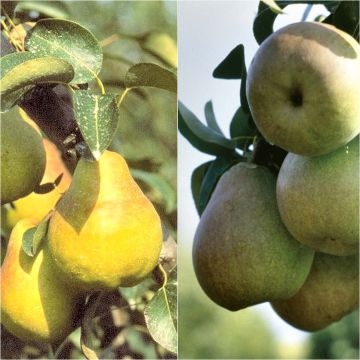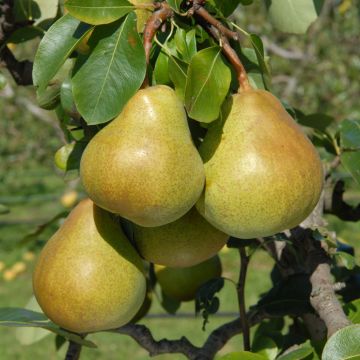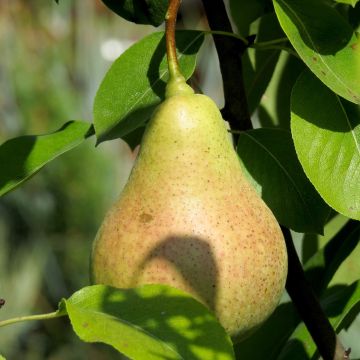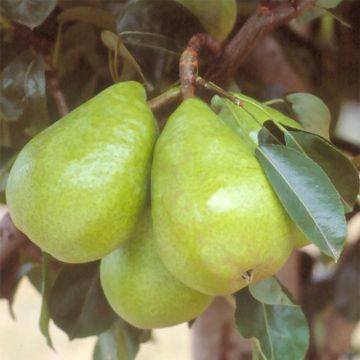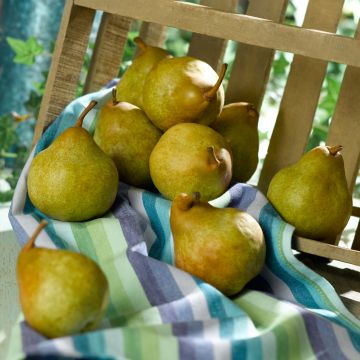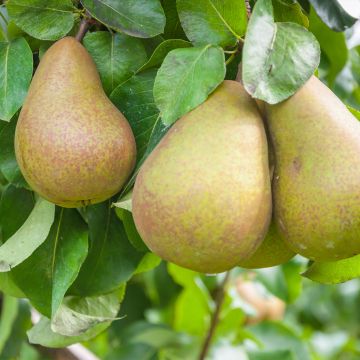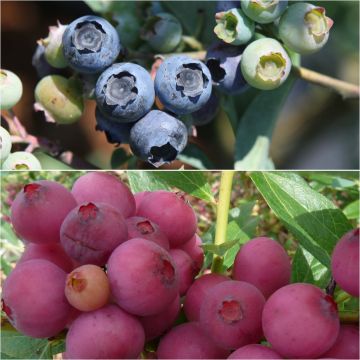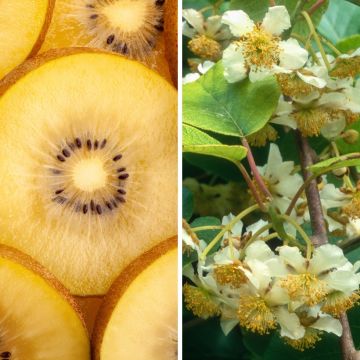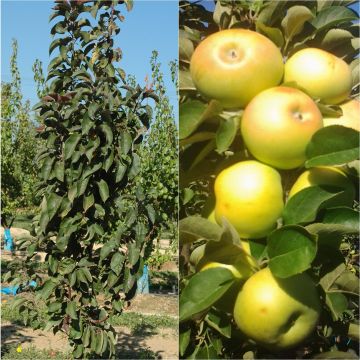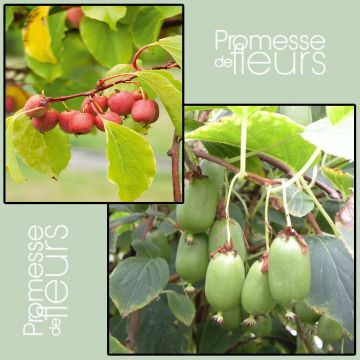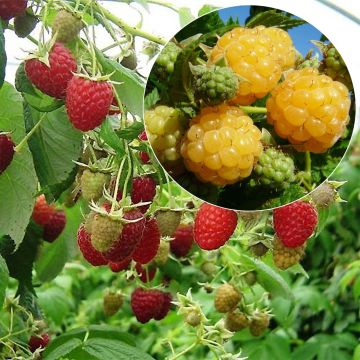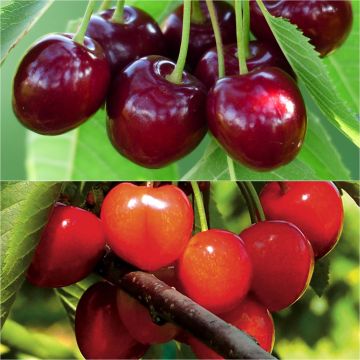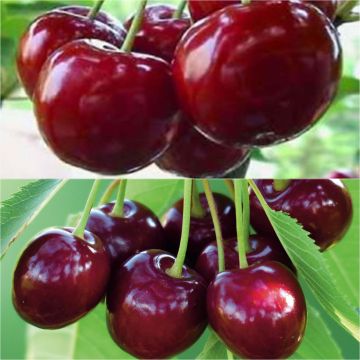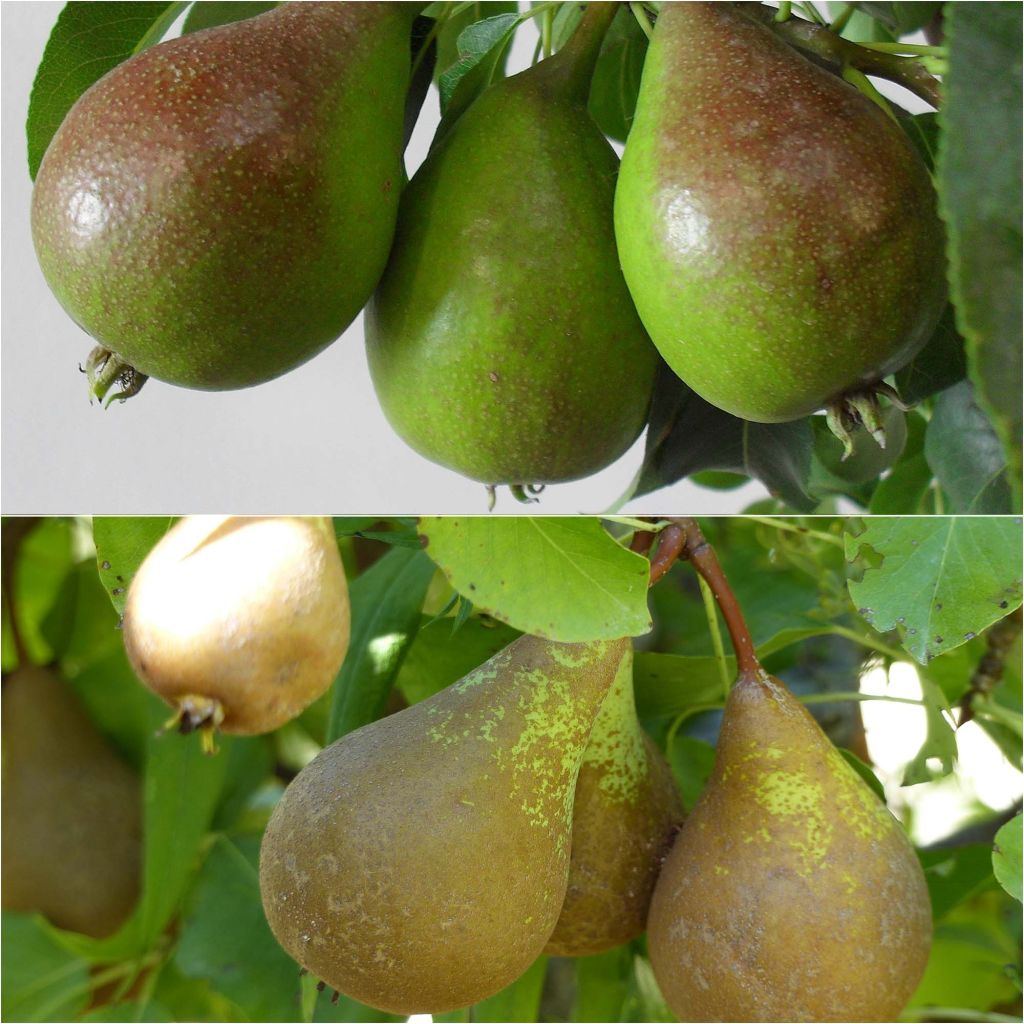

Cup-shaped pear tree pollinator duo
Cup-shaped pear tree pollinator duo
Pyrus communis Louise Bonne d'Avranches, Conférence
2 beautiful specimens with a harmonious shape, with splendid glossy foliage, orange-yellow, still present in this month of November (it should be noted that the pear tree generally adorns itself with sublime autumn colors - for those who wish to combine usefulness with pleasure). I plan to plant them in the coming days, along with all the other bushes, recently ordered as well, which will make up my future mixed hedge (which will replace the monotonous and perfectly useless row of thuja). I think these 2 pear trees will be splendid next to the following bushes (also purchased from Promesse de Fleurs, for the most part): two hazelnut trees, a cherry tree, a cherry plum tree, a "Black Tower" elderberry, a "Diabolo" ninebark, a Lamarck's serviceberry, a Japanese goumi, two fastigiate birches, a "Cagire" eucalyptus gunnii, a "Slender Silhouette" sweetgum, three Ottawa barberries (one "Superba" and two "Auricoma"), a "Winter Flame Anny" red twig dogwood, a grandiflora abelia, an "Orange Glow" firethorn, a "Sunningdale Silver" pampas grass, and finally, two "Bailey Compact" American cranberries. And among the evergreen bushes, there will be five "Baggesen's Gold" lonicera nitida (three and one "Silver Beauty"), two mini "Sparkler" firethorns, and a mini "Kaléidoscope" abelia. This could give some ideas to other gardeners, who knows... I certainly think that the result will be beautiful. :) I also allow myself a little advice: never plant the bushes of a future mixed hedge/bocage too close together. Personally, I plan to respect the adult width of each plant, even if it means that my hedge will take longer to become truly opaque... but I still intersperse evergreen bushes, which are very pleasant due to their presence in winter.
Rebecca, 17/11/2021
Special offer!
Receive a €20 voucher for any order over €90 (excluding delivery costs, credit notes, and plastic-free options)!
1- Add your favorite plants to your cart.
2- Once you have reached €90, confirm your order (you can even choose the delivery date!).
3- As soon as your order is shipped, you will receive an email containing your voucher code, valid for 3 months (90 days).
Your voucher is unique and can only be used once, for any order with a minimum value of €20, excluding delivery costs.
Can be combined with other current offers, non-divisible and non-refundable.
Home or relay delivery (depending on size and destination)
Schedule delivery date,
and select date in basket
This plant carries a 6 months recovery warranty
More information
We guarantee the quality of our plants for a full growing cycle, and will replace at our expense any plant that fails to recover under normal climatic and planting conditions.
Description
This Self-fertile Pear Duo in Goblet Form consists of the varieties 'Louise Bonne d'Avranches' and 'Conference' which pollinate each other. Planted close to each other in the garden, these two fruit trees will produce more. The pear harvest extends from September to November. Plant your pear trees in autumn, in deep, fertile and well-tilled soil.
This duo consists of:
-x1 'Louise Bonne d'Avranches' Pear: a variety of medium vigor, with good regular production. Suitable for all regions and will produce better fruits at higher altitudes. It produces medium-sized pears, nicely coloured with brick red on a yellow background. Of good taste, their fine flesh is sweet and juicy. The harvest takes place in September, just before the fruits reach ripeness, as they tend to become over-ripe. This pear tree is not self-fertile.
- x1 'Conference' Pear: a very hardy variety, not frost-sensitive and not very susceptible to scab, which grows in all regions. The pears, elongated in the shape of a drop of water, reach ripeness by the end of September. Their skin is light green, irregularly marbled with brown. The flesh, cream-colored, is sweet, juicy, slightly firm and granular near the core. Harvested two weeks before ripeness, around early October, they will keep in a cold but frost-free and ventilated place until January.
Tagged separately, in 7.5/10 litre pots.
Although hardy, the Pear tree still appreciates protected and sunny situations, avoid frost-prone and windy situations. It likes fresh and deep soils, but dislikes overly draining and chalky soils. In winter, give it a shovel of wood ash, rich in potash, it will improve flowering and fruit quality.
Its upright habit gives it a tall and slender silhouette that is very harmonious. Its oval-shaped leaves, finely toothed on the edge, have a petiole as long as the lamina and measure about 8 to 9 cm (3 to 4in). They turn yellow before falling in autumn.
Its flowering is late and white, in April, which protects it from frost. Its flowers are formed of 5 white petals and are keenly visited by bees.
Pears can be eaten fresh, in syrup, in pastries, in jams and compotes, and can be used to prepare alcoholic beverages.
A fruit tree trained in the goblet form does not have a central leader (vertical main stem), but branches radiating from its trunk. This particular shape allows for good penetration of sunlight and air into the branches, which promotes fruit development and ripening while limiting the development of diseases.
Report an error about the product description
Plant habit
Fruit
Flowering
Foliage
Botanical data
Pyrus
communis
Louise Bonne d'Avranches, Conférence
Rosaceae
Cultivar or hybrid
Other Pear trees
View all →Planting and care
Plant the pear tree in a sunny location, in acidic or neutral soil, even slightly limestone, cool but not excessively. Ensure proper drainage of the planting hole with a thin layer of gravel. Dig a hole two to three weeks before planting, twice as wide and deep as the pot. On the day of planting, place the tree with its pot in a basin of water, in order to moisten the entire root ball by capillary action. Add compost to the bottom of the hole. Place the tree in the hole, fill with soil mixed with potting soil. Do not bury the graft collar. Firmly pack the soil at the base. The root ball should be completely covered. Water generously.
You can add a small handful of wood ash, rich in potash, during the winter, this will improve fruiting.
Planting period
Intended location
Care
-
, onOrder confirmed
Reply from on Promesse de fleurs
Similar products
Haven't found what you were looking for?
Hardiness is the lowest winter temperature a plant can endure without suffering serious damage or even dying. However, hardiness is affected by location (a sheltered area, such as a patio), protection (winter cover) and soil type (hardiness is improved by well-drained soil).

Photo Sharing Terms & Conditions
In order to encourage gardeners to interact and share their experiences, Promesse de fleurs offers various media enabling content to be uploaded onto its Site - in particular via the ‘Photo sharing’ module.
The User agrees to refrain from:
- Posting any content that is illegal, prejudicial, insulting, racist, inciteful to hatred, revisionist, contrary to public decency, that infringes on privacy or on the privacy rights of third parties, in particular the publicity rights of persons and goods, intellectual property rights, or the right to privacy.
- Submitting content on behalf of a third party;
- Impersonate the identity of a third party and/or publish any personal information about a third party;
In general, the User undertakes to refrain from any unethical behaviour.
All Content (in particular text, comments, files, images, photos, videos, creative works, etc.), which may be subject to property or intellectual property rights, image or other private rights, shall remain the property of the User, subject to the limited rights granted by the terms of the licence granted by Promesse de fleurs as stated below. Users are at liberty to publish or not to publish such Content on the Site, notably via the ‘Photo Sharing’ facility, and accept that this Content shall be made public and freely accessible, notably on the Internet.
Users further acknowledge, undertake to have ,and guarantee that they hold all necessary rights and permissions to publish such material on the Site, in particular with regard to the legislation in force pertaining to any privacy, property, intellectual property, image, or contractual rights, or rights of any other nature. By publishing such Content on the Site, Users acknowledge accepting full liability as publishers of the Content within the meaning of the law, and grant Promesse de fleurs, free of charge, an inclusive, worldwide licence for the said Content for the entire duration of its publication, including all reproduction, representation, up/downloading, displaying, performing, transmission, and storage rights.
Users also grant permission for their name to be linked to the Content and accept that this link may not always be made available.
By engaging in posting material, Users consent to their Content becoming automatically accessible on the Internet, in particular on other sites and/or blogs and/or web pages of the Promesse de fleurs site, including in particular social pages and the Promesse de fleurs catalogue.
Users may secure the removal of entrusted content free of charge by issuing a simple request via our contact form.
The flowering period indicated on our website applies to countries and regions located in USDA zone 8 (France, the United Kingdom, Ireland, the Netherlands, etc.)
It will vary according to where you live:
- In zones 9 to 10 (Italy, Spain, Greece, etc.), flowering will occur about 2 to 4 weeks earlier.
- In zones 6 to 7 (Germany, Poland, Slovenia, and lower mountainous regions), flowering will be delayed by 2 to 3 weeks.
- In zone 5 (Central Europe, Scandinavia), blooming will be delayed by 3 to 5 weeks.
In temperate climates, pruning of spring-flowering shrubs (forsythia, spireas, etc.) should be done just after flowering.
Pruning of summer-flowering shrubs (Indian Lilac, Perovskia, etc.) can be done in winter or spring.
In cold regions as well as with frost-sensitive plants, avoid pruning too early when severe frosts may still occur.
The planting period indicated on our website applies to countries and regions located in USDA zone 8 (France, United Kingdom, Ireland, Netherlands).
It will vary according to where you live:
- In Mediterranean zones (Marseille, Madrid, Milan, etc.), autumn and winter are the best planting periods.
- In continental zones (Strasbourg, Munich, Vienna, etc.), delay planting by 2 to 3 weeks in spring and bring it forward by 2 to 4 weeks in autumn.
- In mountainous regions (the Alps, Pyrenees, Carpathians, etc.), it is best to plant in late spring (May-June) or late summer (August-September).
The harvesting period indicated on our website applies to countries and regions in USDA zone 8 (France, England, Ireland, the Netherlands).
In colder areas (Scandinavia, Poland, Austria...) fruit and vegetable harvests are likely to be delayed by 3-4 weeks.
In warmer areas (Italy, Spain, Greece, etc.), harvesting will probably take place earlier, depending on weather conditions.
The sowing periods indicated on our website apply to countries and regions within USDA Zone 8 (France, UK, Ireland, Netherlands).
In colder areas (Scandinavia, Poland, Austria...), delay any outdoor sowing by 3-4 weeks, or sow under glass.
In warmer climes (Italy, Spain, Greece, etc.), bring outdoor sowing forward by a few weeks.






























